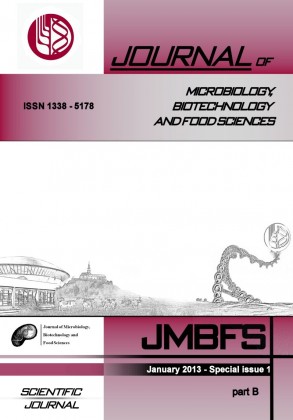WATER HARDNESS AS AN IMPORTANT PARAMETER OF PH
Keywords:
water hardness, pH, mash, fisrt wort, wort, hopped wort, beerAbstract
Quality of final product is to great extent influenced by intermediate products that are formed during beer production. In addition quality of pH is one of the most important properties that forms suitable medium for activity of enzymes complexes that have crucial influence on character of produced wort. Moreover enzymes influence the yield of production process and quality of final product as well. Quality of boiling water and especially its hardness have crucial task in terms of keeping optimal qualitative parameters. Water hardness is given by amount of salts, mainly calcium and magnesium salts. It is expressed as absolute hardness which is given by sum of temporary (carbonate) and permanent (noncarbonate) hardness. In our work we solved the effect of total water hardness on final pH of various intermediate products. We used different water samples and we prepared variants of total hardness by stirring of unpurified water with distilled water thus we achieved various values of hardness. For comparison we prepared several brews with regard to combinations of unpurified water and distilled water. Higher pH of boiling water was caused due to higher water alkalinity that negatively affected enzyme complex present in used malt. Presence of hydrogenphosphates in used malt had high buffering ability and pH lowering ability. Such unfavorable result could be adjust by use of various additions of acidulates that would have in great extent influence on beer final price therefore boiling water adjustment seems to be the most acceptable approach.Downloads
Download data is not yet available.
Downloads
Published
2013-02-01
How to Cite
Tóth, Žigmund, FranÄáková, H., Solgajová, M., & Dráb, Ã…Â tefan. (2013). WATER HARDNESS AS AN IMPORTANT PARAMETER OF PH . Journal of Microbiology, Biotechnology and Food Sciences, 2(special issue 1), 2043–2051. Retrieved from https://office2.jmbfs.org/index.php/JMBFS/article/view/7301
Issue
Section
Food Sciences
License
Copyright (c) 2013 Žigmund Tóth, Helena FranÄáková, Miriam Solgajová, Ã…Â tefan Dráb

This work is licensed under a Creative Commons Attribution 4.0 International License.
All papers published in the Journal of Microbiology, Biotechnology and Food Sciences are published under a CC-BY licence (CC-BY 4.0). Published materials can be shared (copy and redistribute the material in any medium or format) and adapted (remix, transform, and build upon the material for any purpose, even commercially) with specifying the author(s).

